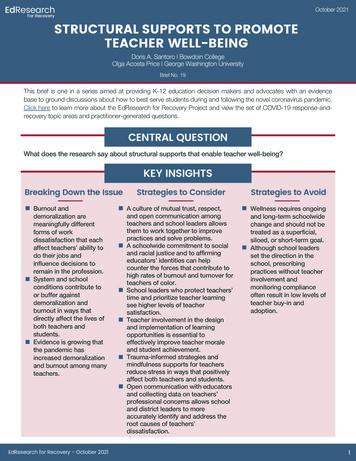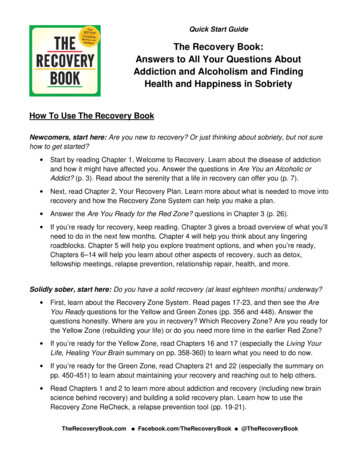
Transcription
EdResearchFor RecoveryOctober 2021STRUCTURAL SUPPORTS TO PROMOTETEACHER WELL-BEINGDoris A. Santoro Bowdoin CollegeOlga Acosta Price George Washington UniversityBrief No. 19This brief is one in a series aimed at providing K-12 education decision makers and advocates with an evidencebase to ground discussions about how to best serve students during and following the novel coronavirus pandemic.Click here to learn more about the EdResearch for Recovery Project and view the set of COVID-19 response-andrecovery topic areas and practitioner-generated questions.CENTRAL QUESTIONWhat does the research say about structural supports that enable teacher well-being?KEY INSIGHTSBreaking Down the IssueBurnout anddemoralization aremeaningfully differentforms of workdissatisfaction that eachaffect teachers’ ability todo their jobs andinfluence decisions toremain in the profession.System and schoolconditions contribute toor buffer againstdemoralization andburnout in ways thatdirectly affect the lives ofboth teachers andstudents.Evidence is growing thatthe pandemic hasincreased demoralizationand burnout among manyteachers.EdResearch for Recovery - October 2021Strategies to ConsiderStrategies to AvoidA culture of mutual trust, respect,and open communication amongteachers and school leaders allowsthem to work together to improvepractices and solve problems.A schoolwide commitment to socialand racial justice and to affirmingeducators’ identities can helpcounter the forces that contribute tohigh rates of burnout and turnover forteachers of color.School leaders who protect teachers’time and prioritize teacher learningsee higher levels of teachersatisfaction.Teacher involvement in the designand implementation of learningopportunities is essential toeffectively improve teacher moraleand student achievement.Trauma-informed strategies andmindfulness supports for teachersreduce stress in ways that positivelyaffect both teachers and students.Open communication with educatorsand collecting data on teachers’professional concerns allows schooland district leaders to moreaccurately identify and address theroot causes of teachers’dissatisfaction.Wellness requires ongoingand long-term schoolwidechange and should not betreated as a superficial,siloed, or short-term goal.Although school leadersset the direction in theschool, prescribingpractices without teacherinvolvement andmonitoring complianceoften result in low levels ofteacher buy-in andadoption.1
EdResearchFor RecoveryBREAKING DOWN THE ISSUEBurnout and demoralization are meaningfully different forms of work dissatisfaction thateach affect teachers’ ability to do their jobs and influence decisions to remain in theprofession.Burnout is a temporary state where individuals have exhausted their personal and organizationalresources in fulfilling their professional duties.Although often portrayed as the capacity for individual resilience, burnout can also be the result of unusuallydemanding school environments that lack appropriate organizational supports or limits.Teachers face high emotional demands in their daily work that can become increasingly debilitating when ratesof student trauma are high.Demoralization is a specific form of dissatisfaction that arises when teachers feel unable to accessthe intrinsic rewards of their work, believe they are complicit in wrongdoing, or find that they areincapable of meeting their ethical obligations.Demoralization occurs when teachers are expected to teach in ways that violate their understanding of goodwork.Good work occurs when:teachers uphold the highest standards of the practice;the work serves a social purpose; andteachers uphold ethical expectations for the practice.System and school conditions contribute to or buffer against demoralization and burnout inways that directly affect the lives of both teachers and students.The quality of a teacher’s work environment plays a major role in determining teacher retention,satisfaction, and effectiveness.Teachers who do not feel supported in their work and who are not provided with the necessary resources aremore likely to leave the profession. Turnover creates lasting negative consequences for schools in terms ofteacher quality and student achievement.Educators experiencing personal and professional stressors are more likely to isolate and retreat fromschoolwide initiatives. Studies have found that teacher burnout can contribute to lower-quality instruction andlower student achievement.In a survey of K-12 teachers across the United States in October 2020, teachers reported lack ofadministrative support as one of the top four variables that significantly predicted teacher burnout.Evidence is growing that the pandemic has increased demoralization and burnout amongmany teachers.Surveys of teachers as the pandemic began highlight the rising stress and plummeting morale thatmany teachers have felt across the course of the year.With the onset of the COVID-19 pandemic, teachers across the board experienced a tremendous drop in theirself-reported “sense of success,” although the drop-off was smaller in schools with more supportive workingconditions.STRUCTURAL SUPPORTS TO PROMOTE TEACHER WELL-BEING2
EdResearchFor RecoveryA RAND survey of 1,000 teachers who left teaching during the first year of the pandemic found that the mostcommon reason teachers cited for leaving was stress.During the pandemic, teachers have been charged with a multitude of extra tasks to ensure learningruns smoothly and students’ needs are met.In a 2012 study, teacher workload was found to be a significant predictor of depression and anxiety.75% of National Board Certified teachers (those who are experienced and have met many standards forexcellence) reported working more hours post-COVID, with 20% reporting working more than 15 extra hours aweek compared to pre-COVID.Online teaching in particular poses additional challenges for most teachers that will likely continue even asmore schools open in person.As the primary contact for parents, teachers serve as the conduit for explaining controversial decisions madeat the district and school level and often receive the brunt of criticism which can be emotionally draining.Teachers are asking for more mental health resources for themselves and their students.A Teach Plus and FuelEd survey of over 500 educators found that teachers want more training and resourcesto support their and their students’ mental health.Teachers who participated in focus groups during the pandemic want their schools to prioritize the well-beingof teachers and students.Unsurprisingly, the events of the last year have only exacerbated the issues faced by educators ofcolor.Educators of color tended to exit the profession at higher rates than their colleagues before the pandemic.Studies examining low retention among educators of color highlight unrecognized and uncompensatedidentity-based labor, disregard for their expertise and assets, educational practices that undermine theirmission-driven purpose, and school cultures rooted in White supremacy.Survey data from educators of color in the 2020 school year found that these educators are facing high levelsof race-based stress in school, which has a significant effect on their professional self-efficacy and sense ofbelonging.STRATEGIES TO CONSIDERThe strategies below should be considered as part of a comprehensive approach to creating policies and conditionsthat work to combat both burnout and demoralization.A culture of mutual trust, respect, and open communication among teachers and schoolleaders allows teachers to work together to improve practices and solve problems.A study of over 400 elementary schools found that principals' actions play a key role in developingand sustaining relational trust in schools. There are four criteria under the umbrella of relational trust:Respect: Genuinely listening to what others have to say and taking their viewpoints into consideration;Competence in Core Responsibilities: The capacity to produce desired results;Personal Regard: Willingness to reach out to parents, teachers, and students; andIntegrity: Consistency between what someone says and what they do.STRUCTURAL SUPPORTS TO PROMOTE TEACHER WELL-BEING3
EdResearchFor RecoveryConsistent structures, policies, procedures, and expectations for teachers help to develop mutuallysupportive relationships and encourage respect and responsibility.Teachers who report having leadership with a system for strong communication are more likely to feelsuccessful.Leaders who celebrate incremental progress in meaningful work can increase staff engagement andhappiness during their workday.A Harvard Business Review analysis of nearly 12,000 daily surveys across seven organizations found that asense of accomplishment, however minor, was the leading indicator of positive perceptions of work,satisfaction, and happiness.District leaders can leverage this “power of progress” by setting incremental goals and helping teachersachieve small successes.A schoolwide commitment to social and racial justice and to affirming educators’ identitiescan help counter the forces that contribute to high rates of burnout and turnover forteachers of color.Teachers in case studies and focus groups led by Education Trust and Teach Plus called for schoolleaders work to build stronger school-community connections, strengthen mentorship opportunities,and compensate teachers for additional responsibilities that can come with being one of the fewteachers of color in a school.Teachers of color are more likely to stay in schools that have a commitment to equity, social justice, and thedismantling of racism — issues that are not necessarily widely discussed or taught in many public schools andare in jeopardy in light of recent legislation in many states.In a 2021 survey of over 2,000 National Education Association educators of color, teachers reported the needfor more guidance on how to address racial justice in the classroom.Affinity groups enable educators to engage in anti-racist and LGBTQIA -affirming work specific totheir racial/ethnic and sexual/gender identities in a manner that supports the well-being of the entireschool community.Addressing the personal and professional well-being of educators of color is vital to recruitment and retention.School leaders who protect teachers’ time and prioritize teacher learning see higher levelsof teacher satisfaction.When school leaders are intentional about supporting teachers’ growth, teachers feel supported andare more likely to remain in the profession.One study that documented differences in collaboration structures and quality across 9,000 teachers in MiamiDade public schools found that teachers who moved to schools with stronger collaborative relationshipsperformed better and their instruction improved more quickly than when they worked in schools wherecollaboration was weaker.Systems that minimize administrative paperwork and set clear expectations for students and familiescan relieve pressure on teachers.Clearly communicating expectations for student behavior to both students and parents, and providingconsistent support to teachers upholding expectations, mitigates the time teachers spend on classroommanagement and allows them to focus on instruction.STRUCTURAL SUPPORTS TO PROMOTE TEACHER WELL-BEING4
EdResearchFor RecoveryA study of nearly 8,000 teachers across nine states showed that leaders play a key role in supportingteachers’ sense of success, particularly when the leaders focused on strong communication andcollaboration with teachers.Teacher involvement in the design and implementation of learning opportunities is essentialto effectively improve teacher morale and student achievement.Multiple studies highlight the mediating effect of teacher autonomy in determining the effectivenessof school systems and structures.A study of teachers across six high-poverty schools reported that they value their instructional team time whenthey have sufficient agency in determining how the time is used and a safe environment where they can openlyexamine their practice.Teacher morale is higher in environments where teachers have the autonomy to exercise their professionaljudgement, be creative, and make decisions about how best to teach their students.Trauma-informed strategies and mindfulness supports for teachers reduce stress in waysthat positively affect both teachers and students.A recent study of a trauma-informed training that aims to equip teachers with strategies to supportstudent social-emotional learning reported significant decreases in emotional exhaustion andimprovements on a variety of stress-related measures for teachers who consistently implemented thecurriculum and participated in ongoing training.Several other well-studied programs, such as Care for Teachers, have improved outcomes for educators byadvancing staff knowledge of compassion fatigue and secondary trauma, and by providing institutionalizedresources to assist with prevention, management, and mitigation of symptoms.Mindfulness trainings for teachers that explicitly teach ways to cope with stress have been shown toreduce teachers’ self-reports of emotional exhaustion and increase teaching effectiveness.Schools can also facilitate teachers’ adoption of positive self-care behaviors by institutionalizing wellnessroutines and procedures throughout the school day.Many schools are experimenting with new types of employee mental health supports focused on the addedstresses brought on by the pandemic.Open communication with educators and collecting data on teachers’ professionalconcerns allows school and district leaders to more accurately identify and address theroot causes of teachers’ dissatisfaction.Teacher resistance may reflect deep professional motivations and commitments.Patterns of teacher dissatisfaction may expose structural inefficiencies or policy flaws.STRUCTURAL SUPPORTS TO PROMOTE TEACHER WELL-BEING5
EdResearchFor RecoverySTRATEGIES TO AVOIDWellness requires ongoing and long-term schoolwide change and should not be treated asa superficial, siloed, or short-term goal.Designating one day, one person, or one initiative as the response to wellness will not improveteacher well-being and does not account for the diversity among teaching staff.Teacher wellness requires strong relationships and effective organizational systems.Positive school cultures take time to cultivate and a commitment of resources to sustain. This work requiresindividual and collective efforts as well as structural changes.Although school leaders set the direction in the school, prescribing practices withoutteacher involvement and monitoring compliance often result in low levels of teacher buy-inand adoption.Administrators who impose preset protocols and mandatory activities or work products without theconsultation of teachers create conditions in which teachers find their instructional planning time lessvaluable.FOR MORE INFORMATIONMore evidence briefs can be found at the EdResearch for Recovery website. To receive updates and the latestbriefs, sign up here.Briefs in this series will address a broad range of COVID-19 challenges across five categories:Student LearningSchool ClimateSupporting All StudentsTeachersFinances and OperationsThis EdResearch for Recovery Project brief is a collaboration among the following organizations and institutions:Funding for this research was provided by the Bill & Melinda Gates Foundation. The findings and conclusions containedwithin are those of the authors and do not necessarily reflect positions or policies of the foundation.STRUCTURAL SUPPORTS TO PROMOTE TEACHER WELL-BEING6
teachers and school leaders allows. them to work together to improve practices and solve problems. A schoolwide commitment to social. and racial justice and to affirming. educators' identities can help counter the forces that contribute to high rates of burnout and turnover for teachers of color. School leaders who protect teachers'










